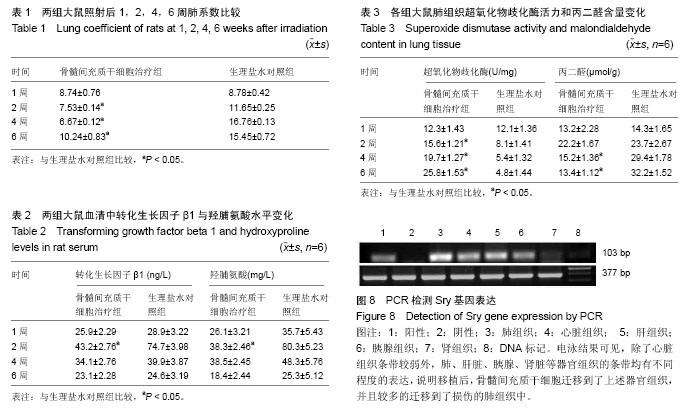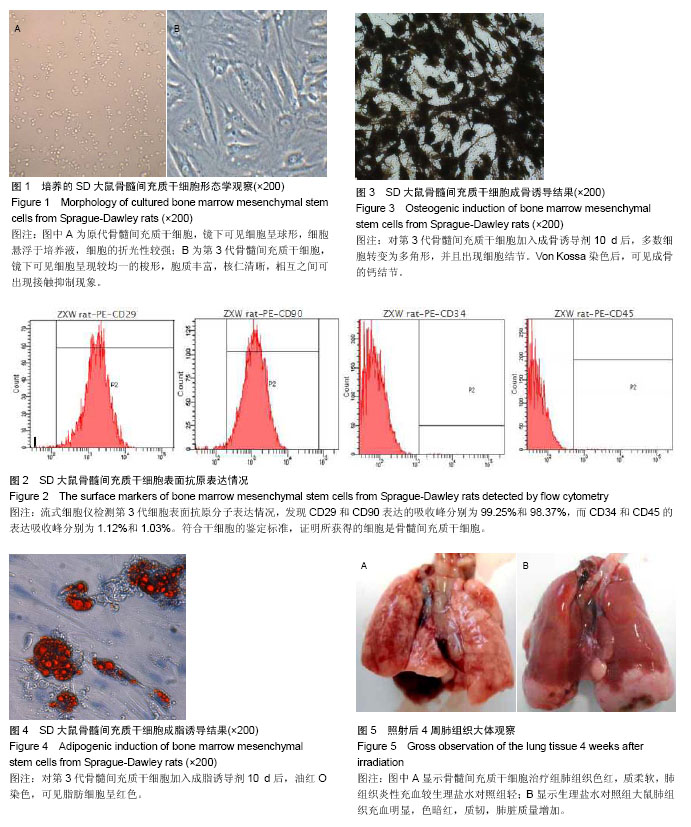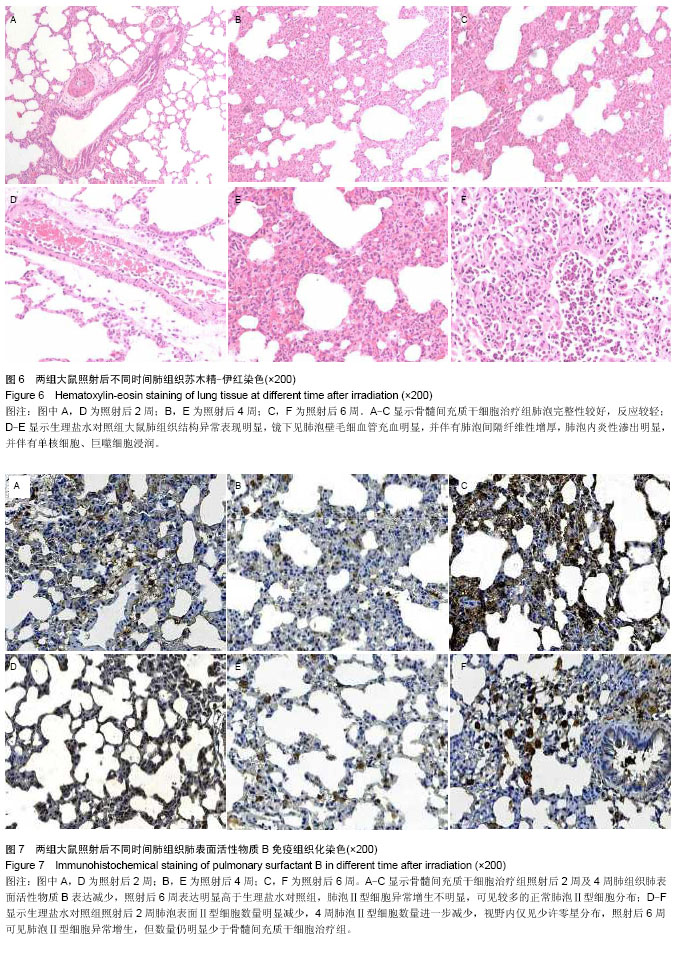设计:随机对照动物实验。
时间及地点:实验于2013年5月至2014年5月在解放军南京军区福州总医院放疗中心与福建省器官移植重点实验室完成。
材料:
实验动物:雄性SD大鼠3只,四五周龄,体质量60-80 g;雌性SD大鼠60只,清洁级,6-8周龄,体质量(200±20) g,均由福州市吴氏实验动物公司提供。
实验方法:
骨髓间充质干细胞的分离培养与鉴定:将雄性SD大鼠处死后无菌条件下获取双后肢,用血管钳夹碎双后肢的干骺端,无菌生理盐水冲洗骨髓腔。收集冲洗液,1 000 r/min离心10 min。吸取底层沉淀物质,加5 mL低糖培养基(LG-DMEM),再加5 mL的Percoll分离液,进行梯度密度离心,2 500 r/min离心10 min。小心吸取第2层云雾状物质,PBS洗涤2次,加10 mL LG-DMEM,2 500 r/min离心10 min。将细胞加入到25 mL无菌培养瓶培养,每24-48 h进行换
|
骨髓间充质干细胞移植治疗大鼠急性放射性肺损伤实验所用主要试剂和仪器:
|
|
试剂和仪器
|
来源
|
|
LG-DMEM、0.25%胰蛋白酶、胎牛血清
|
美国HyClone公司
|
|
Percoll分离液、MTT溶液
|
美国Sigma公司
|
|
油红O染液
|
厦门长生生物技术公司
|
|
PE标记的小鼠抗大鼠CD34、CD45、CD29、CD90单克隆抗体
|
美国BC公司
|
|
转化生长因子β1兔抗鼠单克隆抗体
|
美国Santa Cruz公司
|
|
ELESA试剂盒
|
南京建成生物技术公司
|
|
流式细胞仪
|
美国RD公司
|
|
Bio-Rad 680型酶标仪
|
美国BioRad公司
|
|
6MV-X型直线加速器
|
德国西门子公司
|
|
ABC免疫组化试剂盒
|
美国Sigma公司
|
|
液,当细胞融合面积> 80%时,按照1∶3进行传代培养。
骨髓间充质干细胞生长曲线测定:选择第2,3代细胞,用0.25%胰蛋白酶消化。将细胞接种于96孔培养板,每孔1×104细胞,加入LG-DMEM 200 μL,置37 ℃,体积分数为5% CO2培养箱培养,每两三天换液1次。细胞贴壁后,加入MTT溶液30 μL,置37 ℃,体积分数为5% CO2培养箱培养3.0-4.0 h,加入100 μL二甲基亚砜,用酶标仪在 490 nm波长处测定细胞的吸光度值。
骨髓间充质干细胞表面抗原鉴定:取第3代细胞,加0.25%胰蛋白酶1.5 mL消化5 min,加含体积分数为10%胎牛血清的LG-DMEM终止消化,1 000 r/min离心10 min。将细胞悬液加入EP管,1×106/管。分别加入PE标记的小鼠抗大鼠CD34、CD45、CD29、CD90单克隆抗体15 μL,室温下反应1 h后行流式细胞仪测定。
骨髓间充质干细胞成骨诱导分化:选用第3代细胞,经0.25%胰蛋白酶消化,置于培养箱中培养。待细胞贴壁生长,融合面积> 80%的时候,加入成骨诱导剂(LG-DMEM细胞培养基+体积分数为10%小牛血清+10-7 mol地塞米 松+100 mg/L链霉素+100 U/mL青霉素钠),每48 h换液1次,培养7-10 d,进行von Kossa染色,具体方法为:室温下40 g/L多聚甲醛固定;漂洗2次,滴加AgNO3溶液暗室反应1 h;漂洗2次,苏木精染液复染30 s;自来水冲洗,中性树胶封固。
骨髓间充质干细胞成脂诱导分化:选用第3代细胞,待细胞贴壁生长,融合面积>80%的时候,加入成脂诱导剂(LG-DMEM细胞培养基+体积分数为10%胎牛血清+10 mg/L胰岛素+200 µmol吲哚美辛+0.5 mmol IBMX),每48 h换液1次,培养7-10 d,进行油红O染色,具体方法为:室温下40 g/L多聚甲醛固定;漂洗2次,滴加油红O染液暗室反应1 h;漂洗2次,苏木精染液复染30 s;自来水冲洗,中性树胶封固。
大鼠急性放射性肺损伤模型的建立:1%戊巴比妥钠腹腔内麻醉(4 mL/kg),固定大鼠,铅板屏蔽头部与腹部行直线加速器全胸部照射,总剂量为20 Gy(剂量率5 Gy/min),距靶源距离1 m,照射面积3 cm×3 cm。
实验分组:60只清洁级SD雌性大鼠,随机分为两组,每组30只。骨髓间充质干细胞治疗组:照射造模完成后 30 min内,在大鼠未完全苏醒前,经尾静脉输注雄性大鼠骨髓间充质干细胞(2×109 L-1)悬液1 mL。生理盐水对照组:造模后尾静脉注射等量生理盐水。
标本采集:照射后1,2,4,6周时,每组每个时间点随机挑选6只大鼠用于取材。在禁食、禁水12 h后注射1%戊巴比妥钠腹腔麻醉大鼠,无菌条件下打开腹腔和胸腔,采血针行右心室取血,收集2 mL抗凝全血,4 ℃ 8 000 r/min离心5 min,收集上层血清,置-80 ℃冰箱保存,待测血清中转化生长因子β1、羟脯氨酸水平。剪取双肺,观察肺组织颜色。剪取1 cm3大小肺组织,置-80 ℃冰箱保存,供测组织内超氧化物歧化酶活性和丙二醛含量。再剪取1 cm3大小肺、心、肝、胰腺、肾脏组织,保存于液氮罐中,用于提取RNA,行PCR方法检测肺、心、肝等组织内Sry片段。剩余肺组织用体积分数为10%甲醛固定,留做苏木精-伊红染色观察病理改变及免疫组化法测定肺表面活性物质相关蛋白B的表达。
血清转化生长因子β1与羟脯氨酸水平的测定:
血清转化生长因子β1水平的测定:采用ELASA法,按说明书进行。取微孔板,分别将标本和不同浓度的标准品加入相应的孔中,每孔50 μL,常温放置1 h。每孔加洗涤液400 μL,重复洗涤4次。加入100 μL转化生长因子β1兔抗鼠单克隆抗体,常温反应1 h。洗涤4次,加入100 μL显色剂5,常温静置避光反应30 min。加入100 μL终止液2,用酶标仪测量450 nm处的吸光度值。
血清羟脯氨酸水平的测定:采用ELASA法,按说明书进行。取微孔板,将1 000,500,250,125,62.5,31.3,15.6 ng/L的标准品100 μL分别加入7孔中,在1孔内加入稀释液作为空白对照,其余孔加入大鼠血清100 μL,常温反应90 min。每孔加入100 μL羟脯氨酸兔抗鼠单克隆抗体,37 ℃反应60 min。PBS洗涤3次,加入ABC工作液37 ℃反应30 min。PBS洗涤5次,加入90 μL TMB显色液,37 ℃避光反应30 min。酶标仪在450 nm处测定吸光度值。
肺组织超氧化物歧化酶活性与丙二醛含量的测定:
肺组织超氧化物歧化酶活性测定:准确称取动物组织质量,并按质量(g)∶体积(mL)=1∶9加入生理盐水,冰水浴条件下,机械匀浆,3 000 r/min离心10 min,取上清液,于波长550 nm处测定吸光度值。总超氧化物歧化酶活力(U/mg)=(对照吸光度值-测定吸光度值)/对照吸光度值÷50%×反应液总体积/取样量(mL)÷待测样本蛋白水平(g/L)。
肺组织丙二醛含量测定:组织匀浆制备方法同超氧化物歧化酶。漩涡混匀器混匀,95 ℃水浴40 min,取出后流水冷却,然后3 500 r/min离心10 min,取上清液,532 nm处测吸光度值。丙二醛含量(μmol/g)=(测定吸光度值-对照吸光度值)/(标准吸光度值-空白吸光度值)×标准品浓度 (10 μmol/L)÷待测样本蛋白水平(g/L)。
肺组织苏木精-伊红染色与肺表面活性物质相关蛋白B测定:
苏木精-伊红染色:取甲醛固定的肺组织标本,石蜡包埋,常规切片。切片放入58 ℃烘箱中2 h,烘干后梯度乙醇脱蜡,苏木精染色3 min,流水冲洗,置返蓝液内复染 10 min,流水冲洗,伊红液染色1-3 min,封固后镜下观察。
肺表面活性物质相关蛋白B测定:采用免疫组化法测定肺表面活性物质相关蛋白B表达。切片置60 ℃烤箱1 h。二甲苯中脱蜡15 min,无水乙醇梯度脱水。体积分数为3%H2O2室温10-15 min灭活内源性酶。切片置入枸橼酸缓冲液中,微波炉内抗原修复10 min。加5% BSA封闭液37 ℃反应30 min。加一抗,4 ℃过夜。PBS洗3次,滴加SABC,37 ℃反应30 min。PBS洗3次,DAB显色。蒸馏水冲洗,苏木精复染30 s,蒸馏水内浸泡2 min,再放入饱和的Na2HPO4溶液中2 min,取出后干燥、封固。
肺脏、心脏、肝脏、胰腺、肾脏组织雄性大鼠Sry片段PCR扩增:冰浴下研磨组织,加入500 μL Trizol,37 ℃静置10 min。加100 μL氯仿,混匀后冰浴5 min。10 000 r/min离心10 min,吸取上清液,加入无水乙醇振荡10 s。将得到的液体加入RNA柱,垂直滴加,12 000 r/min离心2 min。在RNA柱内滴加Wash BufferⅠ 500 μL。12 000 r/min离心 2 min,在RNA柱内滴加DNaseⅠ,37 ℃静置15 min。滴加350 μL的Wash BufferⅠ,垂直滴加,10 000 r/min离心1 min。加450 μL的Wash BufferⅡ,垂直滴加,12 000 r/min离心 1 min。加30 μL DEPC,静置5 min,10 000 r/min离心 2 min,得到RNA液体,置-20 ℃冰箱内保存。
引物:上游引物为5’-CCT GAT CCA TCA ACG TAC CTT GCA-3’;下游引物为5’-TTG CCA ATA CGT CAT CAG CCA GCC-3’。反应体系为:肺组织DNA溶液4 μL,PCR缓冲液2 μL,脱氧核糖核苷三磷酸2 μL,耐热DNA聚合酶0.2 μL,氯化镁2 μL,双蒸水10 μL,PRI Ⅰ0.4 μL,PRI Ⅱ0.4 μL。反应条件:95 ℃预变性5 min;95 ℃变性35 s,56 ℃退火50 s,72 ℃延伸1 min,重复35次;最后72 ℃延伸10 min。扩增产物置于琼脂糖凝胶,10 V/cm电场中电泳。
主要观察指标:①血清转化生长因子β1与羟脯氨酸水平。②肺组织超氧化物歧化酶活性与丙二醛含量。③肺组织病理形态与肺表面活性物质相关蛋白B表达。④肺脏、心脏、肝脏、胰腺、肾脏组织雄性大鼠Sry基因表达。
统计学分析:应用SPSS 13.0统计软件处理数据。计量资料以x±s表示,主要采用t 检验,χ2检验,Fisher精确检验。P < 0.05为差异有显著性意义。


